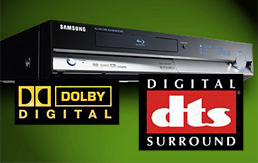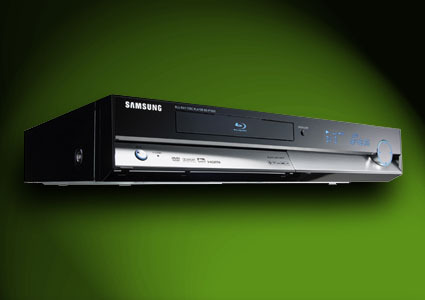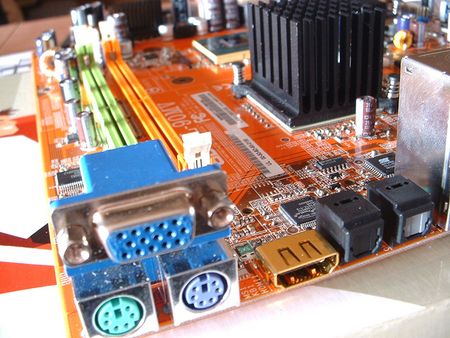Mastering HD PC Audio, Part 1
Add Blu-ray to a PC, and out comes high-def audio, right? Alas, the answer is actually "maybe yes, maybe no." Read on to find out why.

You Can’t Always Get There From Here

When it comes to handling high-definition audio from a Blu-ray player in your PC, you might be inclined to believe that HDMI capability in the motherboard or on a graphics card automatically enables you to output high-definition, high-bandwidth audio formats such as Dolby Digital Plus, DTS-HD High Resolution, Dolby TrueHD and DTS-HD Master Audio. Except for a few interesting possibilities, however, in most cases you’d be dead wrong. Even relatively new, HDMI-equipped high-end motherboards, graphics cards, and sound cards may not be able to accommodate such higher-bandwidth data streams natively. It all comes down to what kinds of inputs they can accept, and what sorts of outputs they are able to emit.
Readers who return to this story will notice it’s been changed since it was originally posted. Thanks to my occasional collaborator, and full-time HTPC maven, Matt Wright, we’ve made numerous corrections and additions to this story, which should hopefully result in its improved usability for our readers, not to mention avoiding additional confusion when there’s already plenty to go around!
We take a look at these audio formats and their bandwidth and delivery requirements in this story. In Part 2, we proceed to examine how digital audio streams may be handled (or not) inside typical PC components. You should walk away from both of these stories with a profound appreciation of why so many home theater PC users end up using multiple analog cables — three for 5.1 sound or four for 7.1 sound — instead of HDMI to ferry multichannel sound where they want it to go. Hopefully, you’ll also begin to understand some of the trade-offs inherent in converting from digital to analog inside a PC instead of in your receiver or pre-amp, if that ends up as the most workable option for realizing the best possible multichannel surround sound experience. And finally, you may learn why it might be worth waiting just a little bit longer to put together a home theater PC with a Blu-ray player as part of your entertainment center; this will let you take advantage of some new hardware capabilities that should be available before 2008 comes to an end, but is not quite ready yet (at least, as I write this story).
Here in Part 1, you’ll find the following elements explored and explained:
- Blu-ray audio formats: This includes Pulse Code Modulation (also called PCM, or sometimes LPCM for the Linear PCM implemented in most audio gear), plus three types of Dolby (Dolby Digital, Dolby Digital Plus, and Dolby TrueHD) and the DTS (DTS, DTS-HD High Resolution, and DTS-HD Master Audio) formats.
- The bit rate (or bandwidth) associated with each format, along with the number of channels, sampling frequencies, and bit depths used to encode the formats.
- Whether or not an SPDIF connection can accommodate the bit rate for each format, and which types of HDMI connectors the format works with.
In Part 2, we look at PC software codecs to describe what formats they can handle, and examine the types of connections that HDMI equipped motherboards, graphics adapters, and sound cards can accommodate. And because new chipsets and connections have recently become available (or will be available relatively soon) we also explain how new and upcoming hardware may someday provide simpler solutions to the sad, sorry, and sometimes confusing state of high-definition PC audio as we know it today.

Sign up to get the BEST of Tom's Guide direct to your inbox.
Get instant access to breaking news, the hottest reviews, great deals and helpful tips.
Current page: Mastering HD PC Audio, Part 1
Next Page Understanding High-Definition AudioTom's Guide upgrades your life by helping you decide what products to buy, finding the best deals and showing you how to get the most out of them and solving problems as they arise. Tom's Guide is here to help you accomplish your goals, find great products without the hassle, get the best deals, discover things others don’t want you to know and save time when problems arise. Visit the About Tom's Guide page for more information and to find out how we test products.
-
dogman-x How many people are dissatisfied with DVD sound quality?Reply
Sure, DVD standard definition picture quality leaves something to be desired on a 1080p monitor, but AC-3 through an S/PDIF cable into a nice home theater receiver and decent speakers seems perfectly good already.
I doubt a higher bit rate coder would make a perceptible difference to most ordinary listeners. The limit of human hearing is just over 20KHz (analog). For digital sampling, you multiply that by around 2.2. For example, phone transmissions are engineered for 3KHz analog and transported at 8KHz digital. So I think these 96KHz and 192KHz sampling rates are a waste. The standard 48KHz is more than adequate for the limits of human hearing.
And then there's the 24-bit sampling depth. There is no audio recording equipment on earth that can record that much dynamic range. And even if it could, nobody would want it. When the source audio track goes to near silent, many listeners will be annoyed. Most well engineered movie sound tracks always have something going (music, birds chirping, etc.) to keep the listener interested. So the dynamic range of most movies could probably be captured with around 12 bits. 16 bits is already more than adequate.
Then there's all the hoopla over compression algorithms. Many audio purists will dismiss any lossy compression algorithms without even giving it a proper listening test. The concept of audio compression goes like this: If you hear an alarm clock ticking, then the alarm bell rings, you don't need to encode the ticking when the alarm rings since no one will hear it. Double-blind listening tests have shown that many lossy encoded sound tracks can't be picked out even by audio mastering engineers (golden-ears people who do this for a living). Interestingly, it's often people with significant hearing loss that tend to pick out the lossy compression algorithms. If you can't hear the high frequencies of the alarm bell, then you'll notice the ticking has gone away.
I suspect all these new Dolby / DTS standards are mostly aimed at getting people to buy new home theater sound equipment. Remember that Dolby Labs & DTS both make a small royalty for each new receiver unit sold. Given that existing audio equipment can always use the core Dolby Digital track (without the higher bit rate extensions) over S/PDIF, I would welcome a Tom's listening review of these new sound schemes to see if there is any real difference. -
etittel Dear Dogman:Reply
If you check out the quality sites that rate DVD audio, you'll see comments from people with very "good ears" that give Dolby TrueHD and DTS-HD Master Audio considerably higher ratings than they give to core Dolby Digital or DTS sound tracks. My own experience on my "less-than-state-of-the-art" but good quality audio gear (5.1 is as high as I go right now, because that's as many speaker as I've cared to purchase, position, and EQ for my home theater rig) confirms these confirms these other claims. I can hear more detail and richer sound when decoding DolbyTrue HD than I can when decoding normal Dolby Digital.
The sites that do a good job of rating Blu-ray DVD audio include Cinema Squid, www.highdefdigest.com (I cited a couple of their reviews in this story), www.blu-ray.com, www.soundandvisionmag.com, and www.hometheaterforum.com. A little digging can turn up loads of opinions around this subject matter, most of which leans in the direction that decoding the lossless codecs indeed requires new (and more expensive) gear, but is worth to those to whom such things matter.
HTH,
--Ed-- -
wiyosaya Hi Ed,Reply
I really hope that you continue to do home theater articles for Tom's. This is, by far, the best article that I have ever seen Tom's publish on home theater. It sounds like a.) you really know your stuff, or b.) you took the time to thoroughly research the topic or c.) both. The in-depth info on the various HD audio formats is fantastic.
I hope that the part 2 article is just as in-depth, and I am hoping that you will at least partly cover the Asus Xonar AV1.
My personal preference is to have a stand-alone Blu-ray recorder, but in the US, those do not exist so far. I have heard rumors that Toshiba will release one later this year, however, if they do, it remains to be seen if it will record from an HDMI input. Perhaps the combination of the Xonar AV1 in a HTPC would provide an acceptable alternative.
Thanks again for the superb article.
Best Regards,
Matthew
-
etittel Gee thanks Matthew. As far as your a-b-c list goes, it's mostly (b) with a growing amount of (a), hopefully heading toward (c)! I've had the good fortune to work with more accomplished home theater gurus including Mike Chin of SilentPCReview.com, and also Matt Wright (formerly of HTPCnews.com, now with missingremote.com), and to establish good relationships with home theater/audio experts at AMD, NVidia, and Intel. With a support network like that, I'm glad to dig into these topics for the readership, as much out of a desire to get out of home theater PCs what I think they should deliver, as out of plain orneriness (when it doesn't work that way) and curiousity (when it does).Reply
And you're right: the only Blu-ray recorders I'm aware of that are currently available include $3,000+ models from Panasonic and Sony available only in Japan at present. It would be quite a coup for the HD DVD champion to be first to market in the US (or anywhere) with an affordable Blu-ray burner.
And yes, I do plan to touch on the Asus Xonar as well as some other upcoming products (most notably from Auzentech, a Korean-based outfit that plans to release direct HDMI 1.3a audio support later this year, and upcoming stuff from Nvidia that promises to do likewise). If anything, I hope you'll find Part 2 even *more* interesting than Part 1...
--Ed-- -
jawshoeaw People claiming music of one standard sounding superior to another may not be doing a double blind test. I've read serious posts about how XM radio sounds as good as a CD - anecdotal evidence is an oxymoron. If studio engineers could not tell the difference in a blind test - well, I trust science not opinion. Unless it's my opinion of courseReply -
vskatusa This is an excellent article on the subject!Reply
I have researched the subject and stopped my build of the media pc when the truth became clear....
The audio part is not ready for prime time yet! -
I am of the middle-aged plus males group where hearing loss becomes rather common, due to nerve damage. Somehow I can still discriminate between media and hardware that are very good versus not good, although there is much of the dynamic range that is no longer heard. Simply, there is much of what is new each year that is just wasted $$$ for those of us with hearing losses. I like new equipment like the next person, but I'm not sure what is worth my money and what isn't.Reply
One avenue that is open to us for saving some money, currently, is by building our own speakers. There are many places via Internet and elsewhere for tutorials and less than retail priced components. -
Awesome article - can't wait for the follow-ups. Quick response to one of the comments above -Reply
wiyosayaI have heard rumors that Toshiba will release one later this year, however, if they do, it remains to be seen if it will record from an HDMI input.
Unfortunately there's no way any device that is HDCP compliant will be recording via HDMI as the HDCP license explicity defines what an HDCP "Presentation" device (any device capable of receiving, decrypting and displaying HDCP protected content) is allowed to do.
The HDCP license says:
---------
A Presentation Device shall not make any copies of Decrypted HDCP Content for any purpose, except for such temporary buffers
---------
And
---------
Decrypted HDCP Content may be temporarily buffered in a Presentation Device to enable and perform the Presentation Function, image processing function (e.g., picture-in-picture display, image overlay, image enhancement and brightness adjustment) or ?freeze frame? of a single frame of Audiovisual Content, provided that such buffer shall not persist for more time than is necessary to perform such function.
--------- -
etittel Dear Jawshoeaw:Reply
You're absolutely correct about the double-blind comparison. That said, if you check the various Web sites I cited in my previous post, they do provide separate ratings and rankings for Dolby Digital versus Dolby TrueHD, and DTS versus DTS-HD Master Audio *for the same movies*. Two separate auditions, two separate rankings from people who know their stuff is good enough for me, though that doesn't mean it needs to be good enough for you. That said, I have personally compared the two sets of tracks on my own equipment and (though I didn't do a double blind comparison because I have only one Blu-ray player to work with) I believe I can hear an audible difference betweeen Dolby Digital and Dolby TrueHD, as do other members of my family, and friends who've come over to watch movies. Again that's only FWIW, which may be more to me than to you.
--Ed-- -
etittel Dear AVenVY:Reply
Great interpretation of the standards. I didn't mean to suggest that this device would allow copying of decrypted HDCP content, though it should finally provide a superior way to burn HD camcorder content onto DVD. The content providers (aka movie studios) would go ballistic if such devices permitted knockoffs of *gasp!* copyrighted material.
--Ed--

